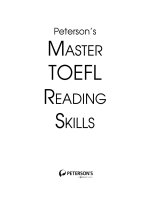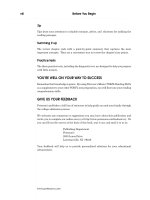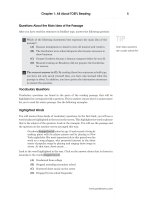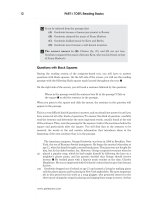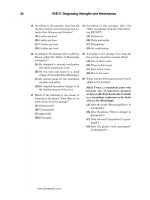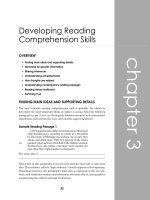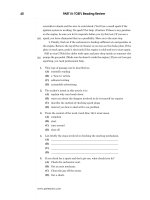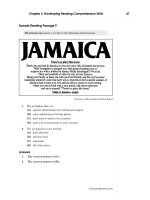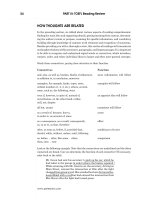Peterson’s master toefl reading skills part 15 ppsx
Bạn đang xem bản rút gọn của tài liệu. Xem và tải ngay bản đầy đủ của tài liệu tại đây (77.49 KB, 7 trang )
Chapter 3: Developing Reading Comprehension Skills 89
www.petersons.com
5. In the postwar years, Germany
(A) had a booming industrial program
(B) had difficulty paying reparations
(C) was optimistic about the future
(D) None of the above.
6. Roosevelt’s “New Deal” advocated
(A) government spending to provide em-
ployment
(B) providing support for the poor and
unemployable
(C) government aid to farmers
(D) All of the above.
7. Four terms of office as President of the
United States would mean
(A) eight years in office
(B) four years in office
(C) sixteen years in office
(D) until he dies in office
QUESTIONS 8–15 ARE BASED ON THE
FOLLOWING PASSAGE.
On September 2, 1945, the Communist
Viet Minh party took over Vietnam and
declared the country autonomous. The
French, however, backed by the British,
returned to Vietnam and forced the Viet
Minh to attend the Fountainebleau Con-
ference in 1946. Ho Chi Minh, the Viet
Minh leader, was inflexible in his de-
mands for unification of his country.
The French had divided it into three
parts: Cochin China in the south, Tonkin
in the middle, and Annam in the north.
A French decree making Cochin China a
separate republic closed the door on any
possible negotiations at the conference.
War broke out between the French and
the Viet Minh.
In the conflict the United States sup-
ported the French, while the Chinese
and the Soviets backed the Viet Minh.
By 1954 public disapproval of the war
and its financial burden forced the
French to withdraw. At a peace confer-
ence in Geneva, Vietnam was divided
with the proviso that reunification would
take place by elections two years later.
The Communists in North Vietnam and
the anti-Communists in South Vietnam
refused to collaborate. Led by Ngo Dinh
Diem, whose regime was backed by the
United States, the South Vietnamese
prevented unification elections and per-
secuted Communists in their region. In
January 1959, militant Hanoi Commu-
nists again declared war, this time against
their own neighbors in the south.
The United States’ involvement in
Vietnam’s internal affairs increased as
President Kennedy sent military advis-
ers in 1961 to assist the South Vietnam-
ese. The war continued. President
Johnson ordered American bombing of
North Vietnam on February 8, 1965.
Ground fighting intensified early in 1968.
Neither side appeared to have gained
ascendancy over the other, and the
American people were fed up with hu-
man and financial losses in Vietnam.
President Johnson ordered a cutback in
the bombing. His successor, Richard
Nixon, continued to support South Viet-
nam but ordered the withdrawal of
American combat troops.
Peace negotiations between the United
States and North Vietnam began in Paris
in May 1968, but were not terminated
until January 27, 1973. Fighting had
reached a deadlock, and the Americans
had renewed their bombing offensive in
December 1972.
With Communist forces remaining in
South Vietnam after the American with-
drawal, the fighting was renewed imme-
diately after the peace conference. South
Vietnam was defeated on April 30, 1975.
The following year Hanoi united North
and South Vietnam. The conflict had lasted
thirty chaotic years. The United States
had supported the losing side with over
half a million troops and billions of dollars.
(5)
(10)
(15)
(20)
(25)
(30)
(35)
(40)
(45)
(50)
(55)
(60)
(65)
(70)
exercises
03_TOEFL Reading Ch 3,31-91 7/29/06, 12:0089
90 PART III: TOEFL Reading Review
www.petersons.com
8. You can infer from the fact that the United
States supported South Vietnamese
leader Ngo Dinh Diem that
(A) he was a poor leader
(B) he was anti-Communist
(C) he was supportive of French coloni-
zation
(D) the United States opposed the French
9. The author’s final statement in this pas-
sage implies that
(A) Americans ought to have stayed out
of Vietnam
(B) Americans should have put more ef-
fort into winning the war
(C) Americans have a tendency to inter-
fere in other nations’ affairs
(D) the cost to the Americans was worth-
while
10. The French withdrew from Vietnam be-
cause
(A) they were weak
(B) the people at home did not sanction
fighting the war
(C) they wanted to divide the country
(D) the Vietnamese hated them
11. Negotiations at the Fontainebleau Con-
ference broke down because the
(A) Viet Minh attended it
(B) French couldn’t make up their minds
(C) Americans interfered
(D) French made Cochin China a sepa-
rate state
12. The apparent cause of the entire Vietnam
conflict was
(A) French refusal to allow unification
(B) Communists’ demands for possession
of North Vietnam
(C) South Vietnam’s withdrawal from the
northern leaders
(D) social upheaval throughout Vietnam
13. In 1959, the war in Vietnam was
(A) an international struggle for power
(B) expected to last a long time
(C) almost over
(D) an internal struggle
14. After seven years of conflict in Vietnam,
the American people
(A) favored increased efforts to win the
war
(B) paid little attention to the war
(C) protested against the waste of the
war
(D) supported the South Vietnamese
15. You can infer that the renewed bombing
of North Vietnam at the end of 1972
(A) destroyed North Vietnam’s forces
(B) contributed to ending the conflict
(C) made the Americans seek peace
(D) caused very little damage
03_TOEFL Reading Ch 3,31-91 7/29/06, 12:0090
Chapter 3: Developing Reading Comprehension Skills 91
www.petersons.com
ANSWER KEY
1. D 6. D 11. D
2. A 7. C 12. A
3. D 8. B 13. D
4. C 9. A 14. C
5. B 10. B 15. B
answers
03_TOEFL Reading Ch 3,31-91 7/29/06, 12:0091
92
www.petersons.com
PART III: TOEFL Reading Review
INTERPRETING SCIENTIFIC READING MATERIALS
As you read the following passages, you will notice that the writing is particularly clear
and precise because of the many technical terms employed. This is characteristic of
science materials. It is important for the author to present ideas in such a way that the
reader can establish relationships between details and facts. As in the previous section,
we will concentrate on some of the study skills taught earlier: scanning, understanding
relationships, and locating specific information.
Sample Reading Passage 21
The moon goes around the earth in an average time of 27 days, 7 hours, and 43.2
minutes. This is called the sidereal period. The lunar month, the period from one
new moon to the next, covers a span of 29 days, 12 hours, and 44.05 minutes. This
is the moon’s synodical period.
The moon is 238,857 miles from the earth. This is considered the mean distance
because the moon’s path is elliptical, not circular. The maximum distance the
moon travels from earth is 252,710 miles, whereas the minimum is 221,463 miles.
These distances are measured from the center of earth to the center of the moon.
The diameter of the moon is 2,160 miles. Deducting the radius of the moon, 1,080
miles, from the radius of the earth, a minimum of 3,963 miles, we get the closest
figure of the bodies’ surfaces, 216,420 miles.
The moon’s rotation on its axis is exactly equal to its sidereal circuit around the
earth—27.321666 days. Although the moon’s circuit is irregular because of its
elliptical course, its rotation is nevertheless regular. The regular rotation and the
irregular rotation create “libration in longitude,” which makes it possible for us to
see first farther around the east side and then farther around the west side of the
moon. On the other hand, “libration in latitude” enables us to see farther over
either the north or the south pole. These two librations allow us to see over 60%
of the moon’s surface at one time or another. The first time the other side of the
moon was photographed was in 1959, by the Soviet spaceship Lunik III. Since
then, U.S. spaceships have taken many pictures of the moon’s surface.
1. What is the meaning of sidereal period? _____________________________
__________________________________________________________________
2. What is the meaning of synodical period? ____________________________
__________________________________________________________________
3. In line 5, what is the meaning of the word mean? _____________________
__________________________________________________________________
4. True or false? The moon’s path around the earth is circular. __________
(5)
(10)
(15)
(20)
04_TOEFL Reading,Ch3,92-104 7/29/06, 12:0192
93
www.petersons.com
Chapter 3: Developing Reading Comprehension Skills
5. In this passage, the word rotation presumably means
(A) by rote
(B) complete turn around a point
(C) planting different crops
(D) balance
6. Revolution of the moon refers to
(A) the moon’s elliptical path around the earth
(B) the moon’s turning on its axis
(C) the turmoil in the composition of the moon
(D) changes in the moon’s surface
7. Librations of the moon cause
(A) it to turn slowly
(B) us to view it from different sides at various times
(C) its irregular course
(D) its distance from the earth
8. True or false? The Russians took the first pictures of the dark side of the moon.
_______________
9. True or false? Sixty percent of the moon’s surface is hidden from us.
_______________
10. How do we determine the distances the moon travels? _________________
__________________________________________________________________
11. Why are two different times given for the moon’s circuit of the earth? ____
__________________________________________________________________
12. What has given us a clearer concept of the moon? ____________________
__________________________________________________________________
13. Why are two distances given for the moon’s distance from earth? ________
__________________________________________________________________
14. What do latitude and longitude mean? ______________________________
__________________________________________________________________
04_TOEFL Reading,Ch3,92-104 7/29/06, 12:0193
94
www.petersons.com
PART III: TOEFL Reading Review
15. Libration in latitude means that
(A) the moon’s diameter is smaller than the earth’s latitude
(B) we see farther over the north and south poles
(C) the moon’s rotation is irregular
(D) the moon’s circuit is regular
Answers
1. Sidereal period is the time it takes for the moon to go around the earth.
2. Synodical period is the period from one new moon to the next.
3. The correct answer is average.
4. The correct answer is false.
5. The correct answer is (B).
6. The correct answer is (A).
7. The correct answer is (B).
8. The correct answer is true.
9. The correct answer is true.
10. We measure from the center of the earth to the center of the moon.
11. One time is the time the moon takes to go around the earth, and the other
time is the period from one new moon to the other.
12. Photographs taken by Soviet and U.S. spaceships
13. The moon’s path is elliptical, not circular.
14. Latitude is the distance north or south of the equator. Longitude is the
position on the earth east or west of a meridian.
15. The correct answer is (B).
Sample Reading Passage 22
About a billion years after the earth had formed, the first signs of life appeared.
Three billion years elapsed before creatures became complex enough to leave
fossils their descendants could recognize and learn from. These were shelled
creatures called trilobites, followed by jawless fish, the first vertebrates. During
the Devonian period, great upheavals occurred in the earth’s crust, resulting in the
formation of mountains and in the ebb and flow of oceans. In the aftermath, beds
of mud rich in organic matter nourished vegetation, and insects, scorpions, and
spiders appeared. Next developed the amphibians, descendants of fish that had
crawled out of fresh water.
Between 225 and 65 million years ago, reptiles developed from which many new
forms grew until finally evolved the mammal. Dinosaurs were overgrown reptiles.
Although some were as small as chickens, others grew to be the largest animals
on Earth, as long as 82 feet and as heavy as 50 tons, with long necks and a liking
(5)
(10)
04_TOEFL Reading,Ch3,92-104 7/29/06, 12:0194
95
www.petersons.com
Chapter 3: Developing Reading Comprehension Skills
for a vegetarian diet. Current theory suggests that dinosaurs were warm-blooded
and behaved more like mammals than like reptiles.
The end of the Mesozoic Era (middle life) saw the inexplicable demise of
dinosaurs and large swimming and flying birds. Geological changes were convert-
ing the giant land mass into separate continents. The beginning of a new era,
called Cenozoic (recent life), saw the marked predominance of mammals that
would ultimately become man’s ancestors.
1. What would be a good title for this reading?
(A) How Reptiles Became Dinosaurs
(B) The Ages of Man
(C) The Evolution of Life
(D) The Formation of the Earth
2. What is required for vegetation?
(A) Dinosaurs
(B) Oceans
(C) Organic matter
(D) Mud
3. What must an amphibian be?
(A) A spider
(B) A person
(C) A creature
(D) A body of water
4. By inference, what would you say insects need?
(A) Water
(B) Vegetation
(C) Mud
(D) Organic matter
5. What does the prefix Meso mean in Mesozoic?
(A) Mixed
(B) Middle
(C) Median
(D) Mean
6. Presumably over in the word overgrown means
(A) above
(B) often
(C) on top of
(D) excessively
(15)
(20)
04_TOEFL Reading,Ch3,92-104 7/29/06, 12:0195
